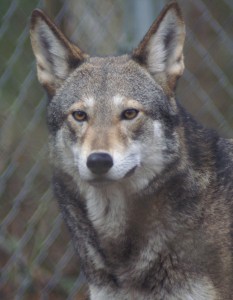 SSP, AZA, USFWS, ARNWR, RWC, PDZA, RWSSP, RWRP. These are all acronyms used when talking about the Red Wolf Recovery Program (RWRP). Originally, I was just going to explain what a Species Survival Plan (SSP) is, so that the readers can have a better idea of how the red wolf breeding program works. But it’s not that simple, because there are several facets of the program. Here is an overview for you.
SSP, AZA, USFWS, ARNWR, RWC, PDZA, RWSSP, RWRP. These are all acronyms used when talking about the Red Wolf Recovery Program (RWRP). Originally, I was just going to explain what a Species Survival Plan (SSP) is, so that the readers can have a better idea of how the red wolf breeding program works. But it’s not that simple, because there are several facets of the program. Here is an overview for you.
The U.S. Fish and Wildlife Service (USFWS) took interest in restoring the red wolf in the 1970’s and started the RWRP as a result. They are charged with the recovery of the species, including the red wolf’s successful re-introduction to the wild at the Alligator River National Wildlife Refuge (ARNWR) and getting re-established in their native territories. The Red Wolf Coalition (RWC) currently consists of one full-time staff member, Kim Wheeler, who works in the red wolf recovery area. She also works very closely with the USFWS to make sure events and other needs are taken care of within the RWRP.
Since the USFWS oversees the wild population, the captive component of the recovery program is run by the Red Wolf Species Survival Plan (RWSSP). Species Survival Plans (SSPs) are programs set up by the Association of Zoos and Aquariums (AZA). You can click here to learn more about what an SSP is. One of the biggest aspects that the RWSSP oversees is the captive breeding. The Point Defiance Zoo and Aquarium (PDZA) is the institution responsible for the first successful captive red wolf births in 1977.
Any institution, such as a zoo or museum, that houses captive red wolves is automatically part of the RWSSP. There are currently 42 of these institutions, which are also known as cooperators. Each institution has a representative (our representative is Sherry), and they work together with the USFWS to decide the best breeding pairs every year and transport wolves accordingly so that they can be paired together at different institutions. (You can read more about the museum’s recent transports in some previous posts about our wolf brothers, our new female, and our new male).
Will Waddell is the RWSSP Coordinator; he is responsible for all the RWSSP cooperators. There is also a RWSSP management team, which consists of 5 or 6 people (all of whom are cooperator representatives) that serve as an advisory group for Will Waddell. Our animal department director, Sherry, is also on that management team.
And of course, another very important part of the RWRP (although they don’t have a cool acronym to go with their title) is the red wolf field biologists and outreach personnel that work so hard every day to help sustain the wild red wolf population and educate the public about the importance of this species (you can read more about red wolf field biologists here).
It just goes to show how much effort goes into saving red wolves, and there are other endangered species that have just as many dedicated people working toward their survival, as well. But it’s obvious that the hard work pays off, since red wolves now roam the wild once more.
So how confusing was that? Do you feel like you have a good understanding of the Red Wolf Recovery Program now, or do you just feel confused? I wasn’t sure if I should publish this post for fear of it being too confusing, so leave me a comment and let me know what you think!
NALOPKT
Summer: many places require a four year college degree. There are also associates programs (2 year degree) directly related to animal keeping.
Science, animal related, and math courses are certainly a huge plus.